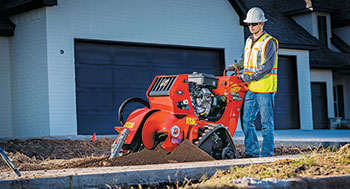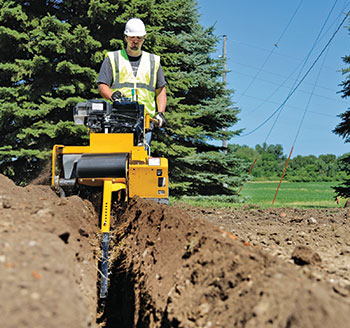
Talk may be cheap, but trenchers sure aren’t. For most landscape pros, trenchers aren’t everyday purchases, so it’s important to consider the bigger picture.
“Understand where you see your company going over the next several years and try not to box yourself in,” says Ed Savage, Vermeer’s product manager for utility tractors and pile drivers. “It can make that return on investment much better as you move forward with your business.”
Savage and Chris Thompson, product manager at Ditch Witch, offer up their advice for making the most of these large purchases.
Easy does it
One way landscape pros can get the most bang for their buck is to use trenchers to their full capabilities.
“Let the machines do the work,” Thompson says. “Sometimes, people get in trouble because they’ll try to pull or drive the machine harder than they should. The machines are meant to dig, so if you feather the booms down and run the machine properly, it’ll dig for you.”
Savage adds that many recent trencher updates have been made with the end user in mind. For example, he says Vermeer is focused on making controls easier to see and use. On larger trenchers, some controls may even be automated.

“It’s hard to find and retain help. Because of that, you get challenges on trying to train (new employees) on how to operate different pieces of equipment,” he says. “We’re trying to look at ways to make that user interface better so we can shorten the learning curve.”
Thompson says Ditch Witch has released a long-track, short-track option, where operators can move the machine closer to the dig site without giving up stability on the machine. The auger can be placed on the short-track side instead of out in front of the tracks where it would take up extra space.
“That allows the power and the steerability to remain on the machine, brings down the whole footprint of the machine and allows more versatility for that machine,” Thompson says.
Other trencher tidbits
Both Savage and Thompson tout safety as the top item to keep in mind when using a trencher. The keys are to wear proper personal protective equipment and call 811 before digging.
“Also, fully understand the safety guidelines and decals on the machinery and be aware that it’s a piece of equipment with moving parts,” Savage says.
He adds that keeping up with maintenance tasks — such as checking grease points; changing out filters, oils and fluids; making sure chain tension is correct; and ensuring cutting teeth are still effective — can cut down on the total cost of ownership. Each machine is different, so Savage suggests checking the owner’s manual for recommended maintenance intervals.
Thompson also advises landscape pros to check out what kind of support network manufacturers have to offer.
All in all, Thompson says, “The idea behind using a trencher is that it’s going to be a lot less invasive than cutting earth with a backhoe, and it’s going to be faster as well.”


